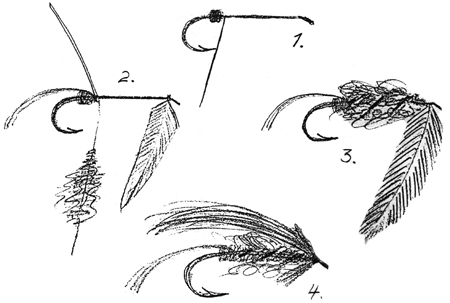


THE SALMON FLIES OF BRITTANY
Michel Fontan
As a salmon fly tyer and a native of France it was only a question of time before I turned my eyes back toward my country in a quest for its salmon fly tying and fishing traditions. I knew that salmon were abundant in many French rivers in the past but, alas, such is no longer true. Sadly, French salmon rivers have suffered the same fate as American rivers with regards to loss of salmon habitat. Yet, many people and associations are trying to bring salmon back to its once native waters. The amount of salmon taken by local fishermen with rod and fly once numbered in the thousands... now they number only in the hundreds.
With this knowledge it was a mix of great joy and concern for the future of Brittany's salmon that I was able to observe for the first time in my life a pair of salmon spawning just a few meters from me this past December in the Scorff, a river that my host Yannn Youen Bouglouan knows quite well.
The tradition of the salmon fly in Brittany is quite different that the English. First, people who fish in Brittany are mainly millers, farmers, laborers of all kinds or "professional fishermen", i.e., those who sell their daily catch of trout and salmon to local restaurants as a way of making a living. Their rods are usually made of two or three pieces of wood taken from local Ash trees.
These are two handed rods generally 14 feet in length. Since there does not exist in Brittany a profusion and richness of exotic materials for fly tying (as there is in England), local tyers must use local sources for their materials.
The following is an English viewpoint by John Kemp from his book Shooting and Fishing in Lower Brittany, written in 1859: "I looked at their queer flies (a bundle of worsted and no wings) and their stiff poles in the place of rods, and wondered how with such tackle they could catch ten or fifteen salmon each per season... He showed my a fly of divers colours and curious manufacture, but did not make believe that he was going to fish with it" he continues: "With respect to salmon flies, I had better recommend to purchase from one of the native anglers. They themselves are very fond of using the Blue Cock's feather for wing which is very efficacious in the clear water..."
Another point of view from Romilly Fedden's Golden Days (1919) and mentioned by Veron S. Hidy in The Pleasure of Fly Fishing"
"The local pattern of salmon flies will doubtless come as somewhat of a shock to the visitor when first he arrives in Brittany. They are indeed gaunt and clumsy looking creatures, in effect, destitute of what we understand as "wings". Only experience can teach that they are here more successful than our customary full winged patterns."
The flies of Brittany generally are unnamed and are simply known by their originators. A lot of them were developed right at water's edge using very simple materials.
The foremost tyer on the Scorff and Elle rivers was a professional fisherman named Francois LeNy. Born in 1905 near the Faouret, he died in Quimperle in 1963 after leading a life dedicated to the persuit of salmon and trout. He was taught by his uncle to fly fish for salmon and used no other technique.
His flies follow a pretty straightforward pattern:
Hook: Down-eyed regular or offset bend, bronzed, and in sizes 2 to 8, including the odd sizes and rarely larger (although I have seen a size 3/0 tied by LeNy).
Thread: Black or grey silk (but mainly black).
Tag: red, yellow, orange or green wool or embroidery cotton in divers shades. Also popular are red claret - "Bordeaux" and a brighter red for Spring salmon.
Tail: Golden pheasant topping, sometimes a hackle point.
Body: Boar underfur, natural colors or dyed with picric acid or onion skin.
Ribs: Tinsel often cut out of a piece of silver or gold paper.
Hackle: Blue cock tied either as a body hackle or collar.
Wing: A mixture of hen peacock's secondary tail feather and golden pheasant tail fibers,sometimes with the addition of a few red fibers of golden pheasant body feather.
The tying sequence is as follows:
1. The wool is tied for the tag, quite heavy after the bend of the hook.
2. The topping is then attached, pointing downward over part of the tag.
3. The hackle, if used as a collar, is then tied at the eye of the hook.
4. The rib and hackle (if using a body hackle) are attached to the hook just after the tail.
5. The main wing of Pheasant, sided with equally long fibers of peacock is then attached and secured over the body.
6. The collar is wound and the head formed and varnished.
Note: Until the 1970's local fly- makers hand-held their flies while tying them and today a lot of tyers are still tying without a vise.
The fly tying and fishing of Brittany is not lost nor forgotten and people are fighting to restore its rivers, maintain these traditions and teach their children to carry them on. My sincere thanks to all of them and particularly to Yann Youen for devoting their love and time to carry on these traditions.
